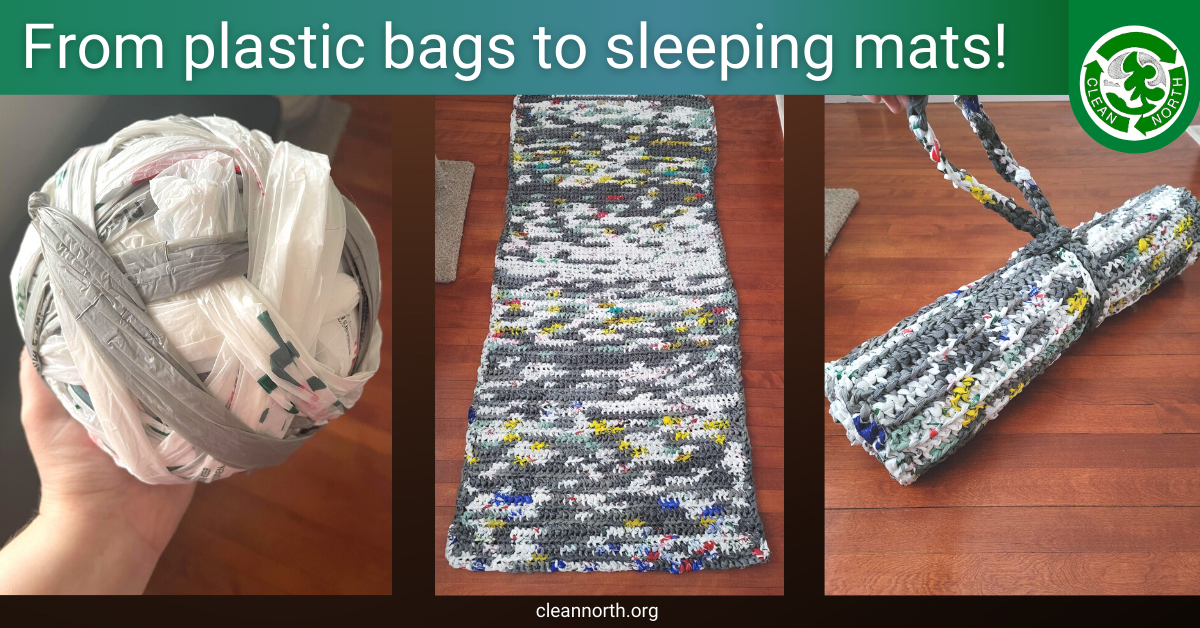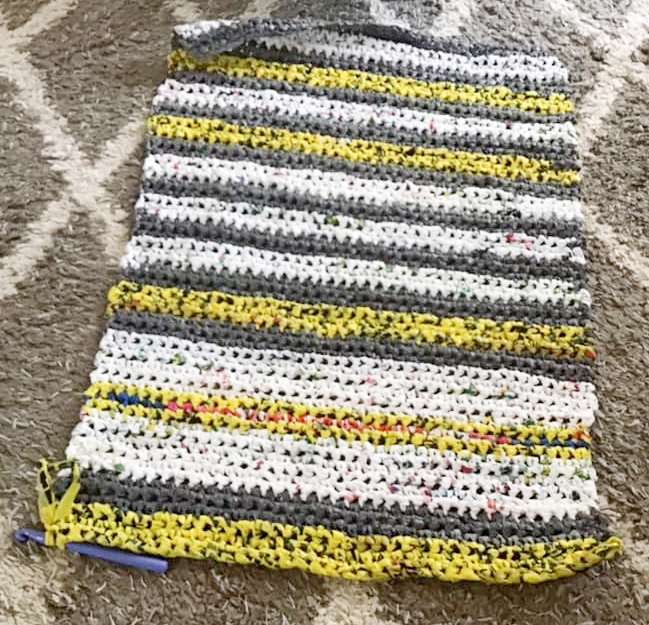By guest writer Abbi Johnston

Did you know that each year in Canada up to 15 billion single-use plastic bags are used? And these bags are estimated to take up to 500 years to decompose in the landfill? However, they don’t truly decompose and end up as microplastics affecting our water. Like a lot of people, I ended up with a lot of plastic bags during the pandemic as stores weren’t allowing reusable ones. I wasn’t sure what to do with them, and then a solution seemed to fall into my lap! I came across a post about the Bags to Sleeping Mats initiative in southern Ontario. This group was crocheting sleeping mats for the homeless using nothing but plastic bags. I was intrigued! I had no idea you could upcycle plastic bags and crochet with them. I was also inspired by the idea of being able to aid the homeless.
How I got started
After reading through the how-to, I ordered a crochet hook (16 mm) and began converting my plastic bags into “plarn” balls. The name plarn comes from plastic and yarn as you use bags to create a yarn-like material.
I then started crocheting. The finished product is supposed to be 2.5 feet wide and 6 feet long. After counting out the recommended number of stitches width-wise, I was only able to get about four inches of mat completed using our whole stash of bags.
I went back to the website to see how many bags were needed – and it said each mat would take about 750 bags. I realized I needed some help collecting enough bags and making plarn, which is more time consuming than crocheting. I reached out to the Zero Waste Sault Ste. Marie group. I was fortunate to get a reply from Cathrine Van Atta, who said she would help by making plarn. With her help, I was able to finish my first mat, and we donated it to Save Our Young Adults.
After completing the first mat, I was ready to keep going! I had learned a lot and was much quicker the second time around. Each mat takes me about 10-12 hours to crochet (plus the time needed to make the plarn) so I was able to complete my second and third mats in about a week each. I have now completed four mats and am working on my fifth. We’re saving these to donate to Sault Ste. Marie Helping Hands, which will be hosting an event to help the homeless on April 14.
Why make plastic mats?
These mats have many benefits for someone who may have no choice but to sleep outside. They are lightweight and waterproof, retain body heat, and have a handy carrying strap. Especially given homelessness is on the rise due to the pandemic, making mats is a small way to help provide comfort to those in need.
Many hands make light work
Recently, we became aware that other people in Sault Ste. Marie were making mats! A great thing about this project is you can do it by yourself, but it’s great to hear that others are supporting the same cause. We learned of Karen Swyers, a local woman who is crocheting blankets to pair with sleeping mats that her friend Chantelle Storkson is making. Elizabeth Robins has also been making mats for Sault Ste. Marie Helping Hands. Lesley Walker is yet another local mat maker. We have been lucky enough to connect with other members of the community through posts on social media, so there are others out there helping as well!

How can you help? If you’d like to get involved with making mats, feel free to check out the link below, which is how I got started. You may also contact Cathrine or me if you have questions on making plarn or mats.
If you have plastic bags you’d like to donate, we’d love to take them off your hands (or you can visit the Zero Waste group on Facebook to track down and donate to other mat makers).
Want to know more?
- Visit the Bags to Sleeping Mats website
- Contact Abbi Johnston on Facebook or abbigail.r.johnston@gmail.com
- Contact Catherine Van Atta on Facebook
- Visit the Zero Waste Sault group on Facebook and search for posts about sleeping mats to find others who are making them




